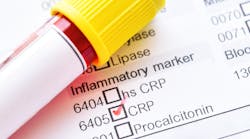Chew the fat: What you need to know about cholesterol and statin use
Decisions, decisions … how do I lower my cholesterol? Do I eat the egg or not? Is it true all cholesterol is bad or if I have low cholesterol that I won’t have a heart attack? How about testing? Are LDL and HDL out and the apolipoprotein B (ApoB) test in? Is statin therapy the right move?
Talking about cholesterol and statin use can land us in the same camp as to use fluoride or not to use fluoride. An array of choices spins before us, each person navigating independently. Luckily, for some, the journey unfolds without a hitch. As dental providers who scrutinize health histories, we know that many of our patients have chosen to use a statin, but we may not know how it can affect oral health.
The American Heart Association estimates that two in five adults in the US have high cholesterol, and tens of millions are prescribed a statin drug. That doesn’t include cholesterol absorption inhibitor drugs or cholesterol-blocking drugs.1
The statin family comprises effective therapeutic agents to reduce cholesterol biosynthesis in the liver and reduce the levels of low-density lipoprotein cholesterol (LDL-C). Other effects include improved endothelial function, anti-inflammatory and antioxidant properties, immunomodulation action, and antithrombotic effects.2-7
Statins and bone health
Bone physiology tells us that following a tooth extraction, we lose dimension of the alveolar ridge. We have systems in place to help, such as bone grafting, but they can often have disappointing results. In a periodontally healthy patient, sometimes root tips have been kept following endodontic treatment to help preserve the ridge for denture retention.
Exploration through the years has shown that statins may promote bone formation and have a positive impact on bone density.8-10 There need to be more randomized clinical trials, but, in one, looking at the healing of third-molar postextraction sockets, the incorporation of 2.0% simvastatin proved superior when compared to other modalities with fewer clinical complications than scaffolds placed without simvastatin.11
Statins facilitate the transformation of bone marrow stem cells into osteoblasts by elevating the gene expression of bone morphogenetic protein-2 (BMP-2). Additionally, statins bolster bone formation by impeding the apoptosis of osteoblasts. In cases of heightened bone turnover, statins curb osteoclastic bone activity, thereby hindering bone resorption.12
How about for dental implants? Statin treatment could be employed to enhance the thickness of the alveolar ridge in preparation for future implant placement. Previous research has investigated the impact of administering statins simultaneously with implant placement. Researchers were able to increase bone formation, promote osseointegration, and enhance implant fixation.13 Applying a statin to the bone bed of an implant, along with topically administered liquid statin, demonstrates improved osseointegration potential for the implant. This approach also enhances the contact between the implant and the newly formed bone.
Statins have been studied for their impact on fracture healing, with promising results observed in rat models. The administration of statins through gel application and local injections demonstrated enhancement in the healing process.14-15
Antibacterial, anti-inflammatory, antioxidant, antiviral, antifungal effects
Statins offer therapeutic benefits beyond lipid-level management, as evidenced in periodontal therapy. In vitro studies have highlighted their antibacterial effects against specific microorganisms, including periodontal pathogens such as Porphyromonas gingivalis and Aggregatibacter actinomycetemcomitans.16 Is it plausible to incorporate statin drugs alongside periodontal treatment?
A meta-analysis conducted in 2017, comprising 11 studies, revealed that when compared to scaling and root planing alone, the supplementary delivery of statins proved effective in reducing pocket depth, clinical attachment loss, and promoting bone defect fill in patients with chronic periodontal conditions.17 Local versus systemic statin use as the adjunct yielded the best results.18 That is not to say on Monday morning load a syringe with a statin and irrigate, but the science is compelling.
Despite the scarcity of studies and recognizing that most of them involve animal subjects, observations indicate that the systemic administration of statins plays a beneficial role in preventing and aiding in the healing process of apical periodontitis.18 Statins may influence collagen synthesis, which is important for the strength and structure of connective tissues, including those in the gums. Statins inhibit enzymes involved with the degradation of tissue such as matrix metalloproteinases (MMPs) and improve epithelialization and wound healing.12,19-20
The anti-inflammatory characteristics of statins may have implications for different oral conditions, particularly in the context of periodontal disease. By easing inflammation, statins have the potential to positively impact gum health. Statins have been shown to lower pro-inflammatory cytokines, C-reactive proteins, and adhesion molecules.2,21-24
There are potential antifungal effects of statins as well. Statins may interfere with the synthesis of ergosterol, a vital component of fungal cell membranes, and possess immunomodulatory properties that can impact the host’s immune response to fungal infections. By modulating the immune system, statins have the potential to augment the body’s capability to combat these fungal pathogens.25
Some studies suggest that statins may work synergistically with traditional antifungal medications, enhancing their efficacy and inhibiting the formation of fungal biofilms, making the fungi more vulnerable to conventional antifungal agents. Conversely, some statins—for instance, atorvastatin—may interact with antifungal drugs, increasing the number of statins in the blood.26
Dentistry has a front seat to two viruses: human papillomavirus (HPV) and herpes simplex virus type 1 (HSV-1). Statins can impact viral infections through various mechanisms. They may disrupt the entry of certain viruses into host cells by inhibiting the fusion of viral and cellular membranes, thereby preventing infection. Additionally, statins could alter the expression and function of specific receptors on the cell surface, making it more difficult for viruses to attach and enter host cells. Furthermore, the observation of statins interfering with the replication of specific viruses within host cells highlights the contribution of their anti-inflammatory and immunomodulatory properties to impacting immune responses.27
There is some exploration into using statins in combination with traditional antiviral medications to enhance the overall efficacy of treatment against HSV-1. This is not, however, standard clinical practice.
In the case of HPV, the question remains: could statins reduce the burden of virus-mediated cancers?
Statins exhibit antioxidant effects through diverse mechanisms. By suppressing the activity of pro-inflammatory molecules, they actively contribute to reducing oxidative stress. In conditions like periodontal disease where chronic inflammation prevails, this reduction is particularly significant. Statins also enhance the availability of nitric oxide (NO), a crucial molecule that safeguards blood vessels from oxidative harm. Additionally, statins decrease the production of reactive oxygen species (ROS), playing a role in mitigating oxidative damage to cells and tissues. Moreover, statins may stimulate the body’s internal antioxidant defense mechanisms, aiding in the neutralization of free radicals.
The controversy surrounding statins underscores the importance of individual discussions between patients and their physicians. However, this focus revolves around exploring the broader effects of this extensively prescribed medication. To establish expertise in both systemic health and oral care, it is essential to thoroughly investigate diverse interconnections across various domains.
Editor's note: This article appeared in the April/May 2024 print edition of RDH magazine. Dental hygienists in North America are eligible for a complimentary print subscription. Sign up here.
References
- Tsao CW, Aday AW, Almarzooq ZI, et al. Heart disease and stroke statistics—2022 update: a report from the American Heart Association. Circulation. 2022;145(8):e153-e639. doi:10.1161/CIR.0000000000001052
- Jain MK, Ridker PM. Anti-inflammatory effects of statins: clinical evidence and basic mechanisms. Nat Rev Drug Discov. 2005;4(12):977-987. doi:10.1038/nrd1901
- Mundy G, Garrett R, Harris S, et al. Stimulation of bone formation in vitro and in rodents by statins. Science. 1999;286(5446):1946-1949. doi:10.1126/science.286.5446.1946
- Chruściel P, Sahebkar A, Rembek-Wieliczko M, et al. Impact of statin therapy on plasma adiponectin concentrations: a systematic review and meta-analysis of 43 randomized controlled trial arms. Atherosclerosis. 2016;253:194-208. doi:10.1016/j.atherosclerosis.2016.07.897
- Parizadeh SMR, Azarpazhooh MR, Moohebati M, et al. Simvastatin therapy reduces prooxidant-antioxidant balance: results of a placebo-controlled cross-over trial. Lipids. 2011;46(4):333-340. doi:10.1007/s11745-010-3517-x
- Sahebkar A, Kotani K, Serban C, et al. Statin therapy reduces plasma endothelin-1 concentrations: a meta-analysis of 15 randomized controlled trials. Atherosclerosis. 2015;241(2):433-442. doi:10.1016/j.atherosclerosis.2015.05.022
- Sahebkar A, Serban C, Ursoniu S, et al. The impact of statin therapy on plasma levels of von Willebrand factor antigen. Systematic review and meta-analysis of randomised placebo-controlled trials. Thromb Haemost. 2016;115(3):520-532. doi:10.1160/TH15-08-0620
- Rakhmatia YD, Ayukawa Y, Furuhashi A, Koyano K. Carbonate apatite containing statin enhances bone formation in healing incisal extraction sockets in rats. Materials (Basel). 2018;11(7):1201. doi:10.3390/ma11071201
- Sezavar M, Bohlouli B, Farhadi S, Tabatabaee S, Latifi R. Simvastatin effects on dental socket quality: a comparative study. Contemp Clin Dent. 2018;9(1):55-59. doi:10.4103/ccd.ccd_719_17
- Wu Z, Liu C, Zang G, Sun H. The effect of simvastatin on remodelling of the alveolar bone following tooth extraction. Int J Oral Maxillofac Surg. 2008;37(2):170-176. doi:10.1016/j.ijom.2007.06.018
- Oliveira MN, Rau LH, Marodin A, et al. Ridge preservation after maxillary third molar extraction using 30% porosity PLGA/HA/ -TCP scaffolds with and without simvastatin: a pilot randomized controlled clinical trial. Implant Dent. 2017;26(6):832-840. doi:10.1097/ID.0000000000000655
- Uzzan B, Cohen R, Nicolas P, Cucherat M, Perret GY. Effects of statins on bone mineral density: a meta-analysis of clinical studies. Bone. 2007;40(6):1581-1587. doi:10.1016/j.bone.2007.02.019
- Tan J, Yang N, Fu X, et al. Single-dose local simvastatin injection improves implant fixation via increased angiogenesis and bone formation in an ovariectomized rat model. Med Sci Monit. 2015;21:1428-1439. doi:10.12659/MSM.892247
- Fukui T, Ii M, Shoji T, et al. Therapeutic effect of local administration of low-dose simvastatin-conjugated gelatin hydrogel for fracture healing. J Bone Miner Res. 2012;27(5):1118-1131. doi:10.1002/jbmr.1558
- Wang JW, Xu SW, Yang DS, Lv RK. Locally applied simvastatin promotes fracture healing in ovariectomized rat. Osteoporos Int. 2007;18(12):1641-1650. doi:10.1007/s00198-007-0412-2
- Emani S, Gunjiganur GV, Mehta DS. Determination of the antibacterial activity of simvastatin against periodontal pathogens, Porphyromonas gingivalis and Aggregatibacter actinomycetemcomitans: an in vitro study. Contemp Clin Dent. 2014;5(3):377-382. doi:10.4103/0976-237X.137959
- Akram Z, Vohra F, Javed F. Efficacy of statin delivery as an adjunct to scaling and root planing in the treatment of chronic periodontitis: a meta-analysis. J Investig Clin Dent. 2018;9(2):e12304. doi:10.1111/jicd.12304
- Ideo F, Manca MF, Niazi S, Mannocci F, Bardini G, Cotti E. The role of systemic statins in the inception and healing of apical periodontitis: a systematic review. BMC Oral Health. 2023;23(1):730. doi:10.1186/s12903-023-03472-3
- Bertl K, Parllaku A, Pandis N, Buhlin K, Klinge B, Stavropoulos A. The effect of local and systemic statin use as an adjunct to non-surgical and surgical periodontal therapy–a systematic review and meta-analysis. J Dent. 2017;67:18-28. doi:10.1016/j.jdent.2017.08.011
- Zhang Y, Bradley AD, Wang D, Reinhardt RA. Statins, bone metabolism and treatment of bone catabolic diseases. Pharmacol Res. 2014;88:53-61. doi:10.1016/j.phrs.2013.12.009
- Martin G, Duez H, Blanquart C, et al. Statin-induced inhibition of the Rho-signaling pathway activates PPARalpha and induces HDL apoA-I. J Clin Invest. 2001;107(11):1423-1432. doi:10.1172/JCI10852
- Yano M, Matsumura T, Senokuchi T, et al. Statins activate peroxisome proliferator-activated receptor gamma through extracellular signal-regulated kinase 1/2 and p38 mitogen-activated protein kinase-dependent cyclooxygenase-2 expression in macrophages. Circ Res. 2007;100(10):1442-1451. doi:10.1161/01.RES.0000268411.49545.9c
- Ridker PM, Danielson E, Fonseca FA, et al. Reduction in C-reactive protein and LDL cholesterol and cardiovascular event rates after initiation of rosuvastatin: a prospective study of the JUPITER trial. Lancet. 2009;373(9670):1175-1182. doi:10.1016/S0140-6736(09)60447-5
- Tousoulis D, Psarros C, Demosthenous M, Patel R, Antoniades C, Stefanadis C. Innate and adaptive inflammation as a therapeutic target in vascular disease: the emerging role of statins. J Am Coll Cardiol. 2014;63(23):2491-2502. doi:10.1016/j.jacc.2014.01.054
- Tavakkoli A, Johnston TP, Sahebkar A. Antifungal effects of statins. Pharmacol Ther. 2020;208:107483. doi:10.1016/j.pharmthera.2020.107483
- Gravatt LAH, Flurie RW, Lajthia E, Dixon DL. Clinical guidance for managing statin and antimicrobial drug-drug interactions. Curr Atheroscler Rep. 2017;19(11):46. doi:10.1007/s11883-017-0682-x
- Gorabi AM, Kiaie N, Bianconi V, et al. Antiviral effects of statins.Prog Lipid Res. 2020;79:101054. doi:10.1016/j.plipres.2020.101054
Anne O. Rice, BS, RDH, CDP, FAAOSH, founded Oral Systemic Seminars after almost 30 years of clinical practice and is passionate about educating the community on modifiable risk factors for dementia and their relationship to dentistry. Anne is a certified dementia practitioner, a longevity specialist, a fellow with AAOSH, and has consulted for Weill Cornell Alzheimer’s Prevention Clinic, FAU, and Atria Institute. Reach out to Anne at anneorice.com.
About the Author

Anne O. Rice, BS, RDH, CDP, FAAOSH
Anne O. Rice, BS, RDH, CDP, FAAOSH, founded Oral Systemic Seminars after over 35 years of clinical practice and is passionate about educating the community on modifiable risk factors for dementia and their relationship to dentistry. She is a certified dementia practitioner, a longevity specialist, a fellow with AAOSH, and has consulted for Weill Cornell Alzheimer’s Prevention Clinic, FAU, and Atria Institute. Reach out to Anne at anneorice.com.


